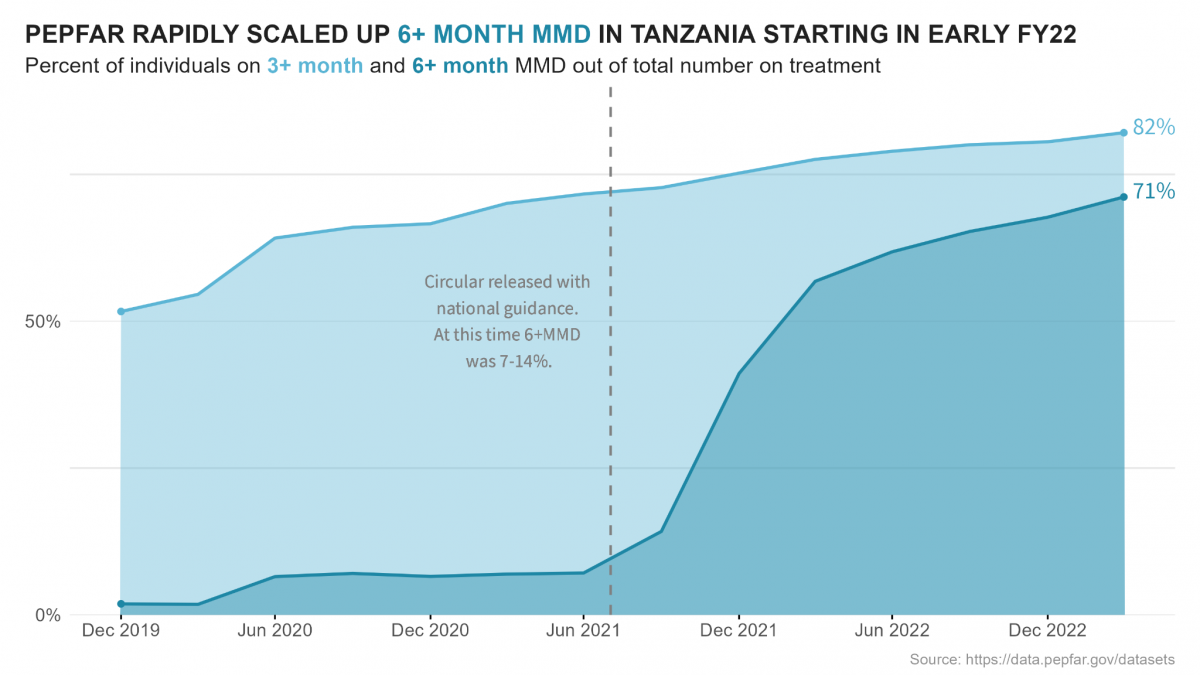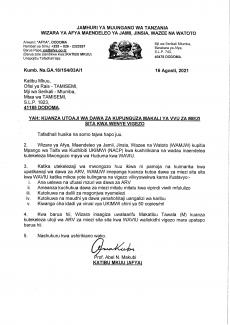Author: Becky Band Jain is a Communications Advisor in USAID’s Office of HIV/AIDS in the Bureau for Global Health.
Multi-month dispensing (MMD)–when people can receive enough ART to last for a period of three months or more–is at the core of client-centered care. It’s also a key component of PEPFAR’s strategy to “deploy innovative solutions to address key barriers to HIV service access.” MMD’s main advantage for clients is its convenience. It enables them to have more agency to take their medications while spending less time and money to get to facilities. MMD implementation also reduces the volume of daily visits at facilities, which can free up time for clinic staff to spend with clients who need extra care.
The widespread benefits of MMD treatment are especially felt in Tanzania, where 1.7 million adults and children are living with HIV, according to UNAIDS. Eighty-six percent of them–1.5 million people–are on antiretroviral therapy (ART). In order to provide more convenient care for clients, reach those not yet on ART, and allow health facilities to focus on those with more pressing needs, Tanzania’s Ministry of Health transitioned to six-month dispensing (6MMD) in a rapid and ultimately successful manner in September 2021. Tanzania is an example of scaling up 6MMD quickly, equitably, and efficiently thanks to technical assistance through USAID’s supply chain support.
In January 2021, nearly a year into the COVID-19 pandemic, Tanzania was procuring the HIV medication tenofovir/lamivudine/dolutegravir (TLD) for the nearly 90 percent of people living with HIV (PLHIV) in Tanzania on 3MMD. But the government had concerns about moving beyond 3MMD due to the large amount of stock that would be needed. However, as the COVID-19 pandemic became more of a health threat and congested clinics became an increasing concern for COVID-19 transmission, the government reconsidered its stance. After a small CDC pilot stage took place in Dar es Salaam, the government decided that it was time for 6MMD to reach the whole country.
In August 2021, the government approved a national rollout strategy and released a national circular (pictured at right) to all health facilities to promote the new guidelines. The first phase of the rollout prioritized high-volume facilities supported by PEPFAR implementing partners in collaboration with regional and district health management teams, followed by low-volume facilities. Each implementing partner had a transition plan guiding the scale-up of the intervention.
To support national rollout, a new data tracker allowed teams to closely monitor eligible clients for MMD. “We looked at how the data would be accessed for collection, the source of information, and who collected it,” says Jacqueline Kalimunda, Public Health Specialist with USAID Tanzania.
The PEPFAR team developed an ambitious transition plan, with a goal to reach 60 percent of 3MMD clients with 6MMD within 6 months. By March 2022 the goal was nearly reached, with 58 percent of people with HIV over the age of 15 on ART receiving 6MMD. By September 2022, nearly 1.1 million people were on 6MMD.

The drastic jump in 6MMD coverage is clear in the above graph.
Clients have been enthusiastic about the change: their daily lives have improved thanks to reduced hospital visits and more time to dedicate to work. Boarding school students were better able to participate in school without interruptions to go to the clinics. Truck drivers stopped having multiple locations for drug pick-up. Health facilities were seeing fewer clients per day, and so health care workers had more time to work on tracking missing and lost clients and other important duties.
Besides MMD, there are other differentiated service delivery options, such as decentralized drug delivery, home delivery, and e-lockers, that support client-centered, convenient care. While other challenges to successful treatment remain for clients, many in Tanzania are now better able to stay on their medications, with more convenience and lower cost, thanks to this rapid rollout of 6MMD and USAID’s support.

The circular that Tanzania’s Ministry of Health released in August 2021.
